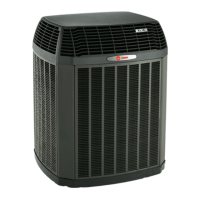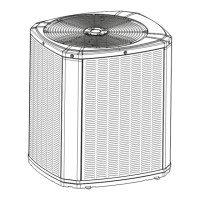Do you have a question about the Trane 4TTV0060A1000A and is the answer not in the manual?
Covers electrical, refrigerant, hot surface, and grounding hazards.
Details unit size and weight for installation planning.
Specifies line sizes and valve connections for models.
Guidelines for optimal outdoor unit placement for performance.
Precautions for units in areas with snow or freezing temps.
Guidelines for units installed near salt water environments.
Procedures for checking unit for damage and removing from pallet.
Requirements for the support pad for the outdoor unit.
Determine line length and vertical change for charging.
Instructions on insulating refrigerant lines for efficiency.
Precautions for using existing refrigerant lines.
Guidelines for routing lines to minimize noise and ensure integrity.
Methods for isolating refrigerant lines within walls.
Procedures for passing refrigerant lines through walls.
Step-by-step instructions for brazing refrigerant lines.
Procedure to pressure test lines for leaks using nitrogen.
Steps for evacuating the system to a specific micron level.
Worksheet and steps for calculating refrigerant charge.
Worksheet and steps for calculating charge in repairs.
Procedure for opening the gas service valve.
Procedure for opening the liquid service valve safely.
Maximum wire length for control wiring.
Diagrams for connecting low voltage wiring.
Safety and compliance for high voltage power supply.
Requirements for installing a disconnect switch.
Explains the meaning of LED indicators on the control board.
Step-by-step guide to starting the system after installation.
Required temperature measurements for subcooling method.
Worksheet and method for adjusting system charge.
Charts to adjust subcooling based on line length and lift.
Chart for determining liquid gauge pressure based on liquid temp.
Steps to adjust refrigerant using gage pressure.
Procedures for system stabilization and performance verification.
Recording system pressures and temperatures after charging.
How to navigate the CDA and its menus.
Explanation of how demand defrost works.
Conditions for initiating and terminating defrost cycles.
Steps to access and perform forced defrost test via CDA.
Comprehensive checklist for final installation verification.
| Type | Heat Pump |
|---|---|
| Tonnage | 5 Ton |
| Refrigerant | R-410A |
| Voltage | 208/230V |
| Phase | 1 |
| Compressor Type | Scroll |
| Cooling Capacity | 60000 BTU |
| Heating Capacity | 60000 BTU |
| Stages | Single-Stage |












